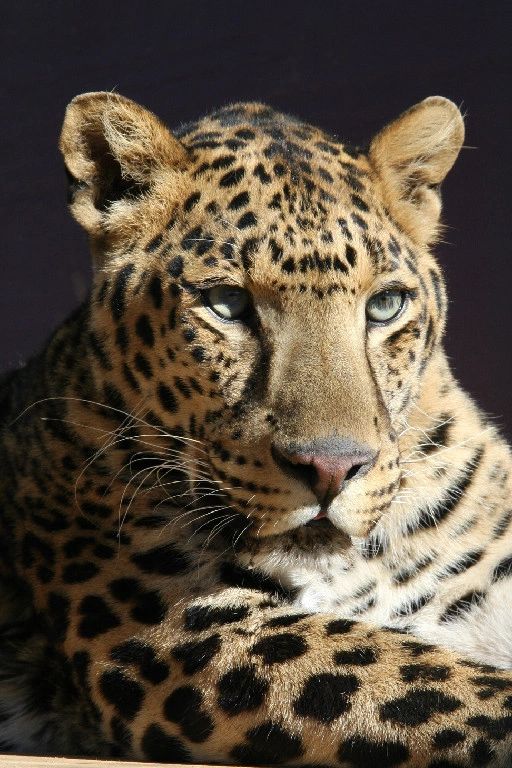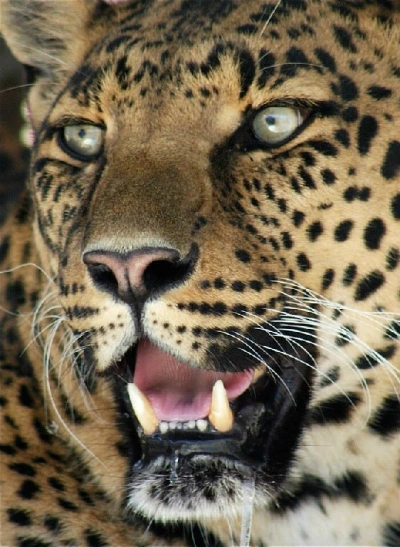
Scientific name: Panthera Pardus

THE ELUSIVE LEOPARD
The strikingly gorgeous leopard is stealthy and secretive, staying as far out of the sight of humans as possible. Infamous for the ability to go undetected, it is very difficult and rare to ever spot one in the wild as he remains elusive up high in the trees or hidden in thick underbrush. Except for the head and legs, the leopard’s body is covered in a light colored coat with distinctive dark spots which are grouped in circles called “rosettes”, because they resemble the shape of a rose. This stunning spotted coat lets the leopard blend in with surrounding bushes and trees, but it can also be the cat’s death sentence. National Geographic has reported that over 2,000 leopards are illegally hunted each year in Africa for their skins. Leopard skins are often used in local rituals by witch doctors and are worn by presidents and church leaders as signs of nobility and power. Threats are terribly great of being poached by trophy and meat hunters or poisoned by farmers who claim to be protecting their livestock.
The name “leopard” was derived from the Greek words for lion (leo) and panther (pardos). They are graceful and massively powerful with long elegant bodies, broad chests, thick necks, short muscular legs, big paws, long tails and long white whiskers, which are stiff and very sensitive. The whiskers help the cat feel their way through thick underbrush in the dark and the tail is just about as long as its entire body, helping with balance and enabling it to make sharp turns quickly. Their heads are massively large with hight cheekbones and mesmerizing golden or green eyes. Although the leopard is not the largest cat in the wild, what it lacks in size is made up for in strength. Serious injuries can be inflicted on on the cat’s enemies using its sharp teeth and claws if challenged. Lions and tigers usually have no interest, whatsoever, in engaging in battle against an adult leopard.
Today leopards inhabit regions of Africa, India, Central Asia, Siberia, the Middle East and China. They are very versatile and diverse animals that can adapt easily to all kinds of climates and conditions, living in ranges in semi-desert areas, rocky mountainous areas, tropical rain forests or swamps. There are nine remaining subspecies and four of them are on the Critically Endangered list published by the International Union for Conservation of Nature (IUCN). They are the African, Amur, Arabian, Indian, Indo-Chinese, Java, North China, Persian and Sri Lankan Leopards. The Amur leopard that is found in Russia is one of the rarest cats in the world and is on the verge of extinction, with around only 30 left in the wild.

Leopards are the smallest but most accomplished stalker of the four species belonging to the Big Cat family Felidae which also includes lions, tigers and jaguars. Only these four types of cats can roar. All other cats such as lynxes, bobcats and cheetahs can purr, but not roar. The roaring cats are called the “Great Cats” to distinguish them from other large cats, called “Lesser Cats”. The cunning and stealthy leopard is the ultimate cat and usually considered top predator in its home range. The physical appearance of this cat is sleek, fascinating and very beautiful. It weighs on average between 130 pounds and 200 pounds and is, pound for pound, the most powerful cat in the world. The leopard the strongest climber of all the big cats and strong swimmers that are very much comfortable in the water, sometimes feeding on fish and crabs. Like house cats, they do not like stepping into water but can swim quite well if they have to. They can run as fast as 40 miles per hour and jump up to 10 feet straight into the air. Of all the predators in Africa, the leopard is the second fastest sprinter after the cheetah, running up to 36 miles per hour making up for their short legs with speed and massive power. This cat’s exceptional hearing is more than two times better than people and its excellent vision is six times better than that of a human, makes it a superb hunter at night. Solitary and nocturnal it is most active after dark, moving carefully and quietly in search of the next meal.
Since adult leopards are such powerful animals they rarely have any predators in the wild, except for humans. Because they are solitary, occasionally they may be ambushed or surprised and killed by baboons, pythons, hyenas, lions or wild dogs . Eagles can also be a serious threat to cubs, snatching them up as they try to feed or drink water from watering holes. Leopards are nocturnal predators that stalk prey by stealthy movements in the tall grass. They also hunt from trees where their spotted coats also them to blend with the foliage of the trees until there is an opportunity to pounce with a deadly vengeance. They are so strong and comfortable in the trees that many times they will drag their kill, up to twice their own weight, into the branches to keep its meal safe from scavengers such as hyenas. At night they straddle and sleep high up on tree branches. They mark their territory with urine and feces, as well as clawing the barks of trees. The leopard call is a distinctive a series of grunts sounding like a wood plank being cut with a saw - tending to occur in the early evening or just before dawn. The call allows territorial neighbors to stay out of their way and also allows males and females to locate one another. They will growl when aggressive then spit and snarl when threatened. On average, they live about 12 years in the wild and have been recorded up to age 27 in captivity.
Most time is spent by these cats draped on tree limbs or lying in thick undergrowth to camouflage their spotted coats. They can live without drinking for up to a month, as their need for water is primarily satisfied by the fluids from the prey the eat. Leopards specializes in ambushing and stalking prey, then pouncing before the victim can react. It then paralyzes its prey with a lethal bite to the back of the neck that crushes the spinal cord strangling the victim with its brutally powerful jaws. Known for its amazing climbing ability, the leopard usually drags its kill vertically to a safe place up in the trees to protect it from other predators. Prey of the leopard ranges from the dung beetle to the adult male eland, which can reach 2,000 pounds. The massive power and strength of a large adult leopard means it is capable of killing prey up the almost ten times its own weight. Small prey such as small birds and rodents can be swatted to death with a single strike of the paw. It lurks in the shadows waiting for the perfect opportunity to pounce and will opportunistically take whatever prey is available- sometimes having two kills at once Leopards have a very high success rate on kills made in hunts. If it misses, the leopard will seldom chase its prey. The diet is broad but the favorite meal choices tend to be antelope, warthog, baboons, hares, and vervet monkeys. They will also scavenge when necessary, stealing kills from lone hyenas, cheetahs and other small carnivores. Leopards are not fond of eating fur so before opening the carcass to feed on the meat, it will pluck out the animal’s hair.

Black leopards, commonly called black panthers, appear to be solid in color but when examining them closely you can see the dark rosettes in the coat. The black fur occurs due to color variation and they are not a sub-species. Zoologically speaking, the term panther is synonymous with leopard. Therefore, by strict definition, the term “black panther” refers only to the black leopard. Melanism is caused by a recessive genetic trait that is passed from one generation to the next and is thought by many to be a favorable evolutionary mutation for the species. A black leopard cub can be born if both parents carry the melanistic gene. If both parents are black, the cubs will always be black and quite often a black cub is born along with other fair-colored cubs. Black leopards are most commonly found in dimly lit dense tropical rainforests of South and Southeast Asia, where their dark color gives them greater camouflage.
In the early 1960s and 70s, hundreds of leopards were killed for their beautiful fur causing the population of the species to decrease dramatically. It is currently estimated that there are around 50,000 leopards worldwide. The U.S. Endangered Species Act has since listed leopards on the African continent as “Threatened” (South Africa) and “Endangered” (the rest of Africa and Middle East & Asia). In the 1970s, all leopards were listed as vulnerable by the World Conservation Union (IUCN), and international trade in leopard was prohibited. In July 1975 the Convention on International Trade in Endangered Species (CITES) banned the sale of leopard skins. Since then, the hunting of leopards has been prohibited by law in most countries but illegal poaching is still the greatest threat to the survival of the species. Because coats of leopard fur are extremely expensive, many poachers are willing to risk getting arrested and punished for the possible monetary reward. In recent years the wearing of leopard coats has become less popular as public awareness about the endangered status of leopards has increased. However, body parts such as the teeth, bones, claws, and whiskers are even more valuable today than the furs of the leopard. Some of the body parts are essential ingredients in ancient Chinese medicines and are a huge commodity on the underground black market.
Of all the predators, the leopard is most likely to become a man-eater because of established territories close to human settlements, which results in regular encounters with people.Despite the dark side of the human race, these big cats are trying to survive in a dangerous world. Leopards, like all members of the big cat family, have no greater enemy in nature than human beings. Their survival is greatly challenged due to the mounting threats against them. The habitats for leopards and many other species receive constant pressure due to human encroachment, poaching and intense persecution. Farmers have killed them with poison and traps to protect livestock or people. Hunters continue killing them for adventure and for their beautiful and precious coats. As more and more people continue to settle in developed areas, others have begun to move into the natural habitats of the leopards where they are clearing roads to build more towns and farms, diminishing the areas in which they live. Environmental contamination such as mercury and other chemicals is also a cause of death of wild animals all over Africa. Conservation efforts must be made to repopulate the leopard species or they will all quickly be on the road to extinction.














